为什么存在动态内存开辟
我们已经掌握的内存开辟方式有:
int val = 20;//在栈空间上开辟四个字节
char arr[10] = {0};//在栈空间上开辟10个字节的连续空间
但是上述的开辟空间的方式有两个特点:
- 空间开辟大小是固定的。
- 数组在申明的时候,必须指定数组的长度,它所需要的内存在编译时分配。
但是对于空间的需求,不仅仅是上述的情况。有时候我们需要的空间大小在程序运行的时候才能知道,那数组的编译时开辟空间的方式就不能满足了。这时候就只能试试动态存开辟了。
动态内存函数的介绍
1.malloc和free
malloc是C语言提供的一个动态内存开辟的函数,函数原型如下:
void* malloc (size_t size);
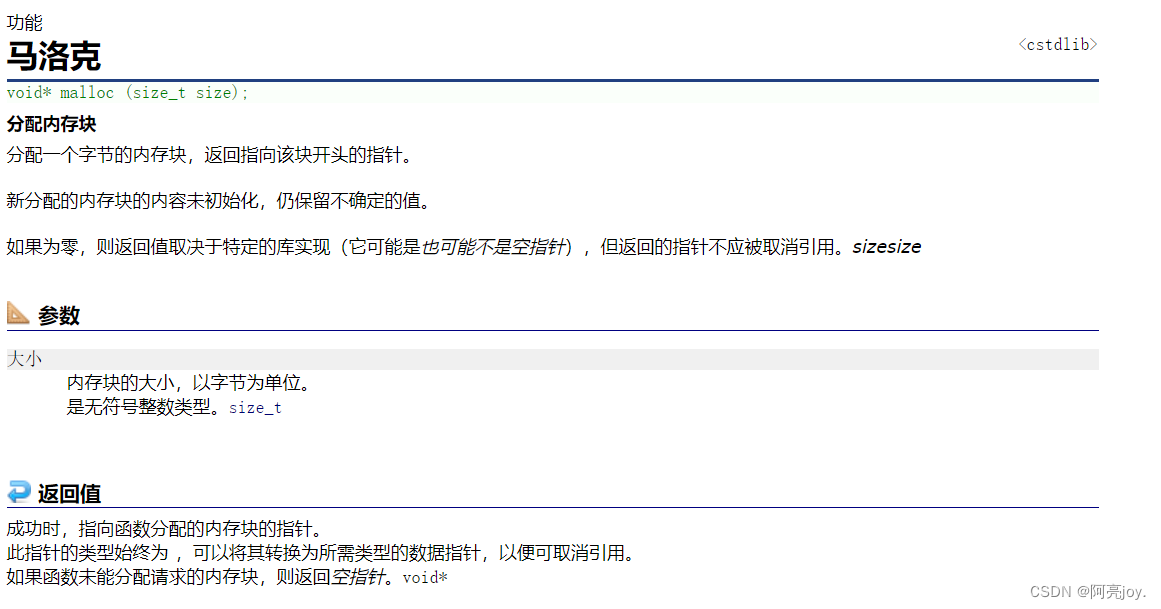
malloc函数向内存申请一块连续可用的空间,并返回指向这块空间的指针。对于malloc函数,我们需要注意一下几点:
- 如果开辟成功,则返回一个指向开辟好空间的指针。
- 如果开辟失败,则返回一个NULL指针,因此malloc的返回值一定要做检查。
- 返回值的类型是 void* ,所以malloc函数并不知道开辟空间的类型,具体在使用的时候使用者自己来决定。
- 如果参数 size 为0,malloc的行为是标准是未定义的,取决于编译器。
C语言提供了另外一个函数free,专门用来释放和回收动态开辟的内存,函数原型如下:
void free (void* ptr);
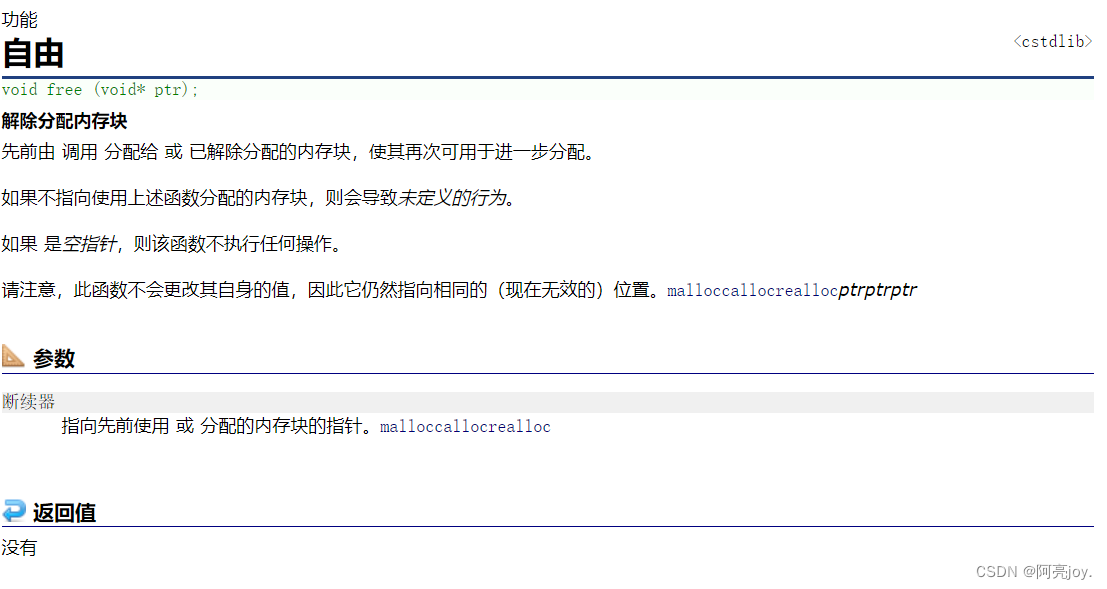
对于free函数,我们需要注意一下几点:
- 如果参数 ptr 指向的空间不是动态开辟的,那free函数的行为是未定义的。
- 如果参数 ptr 是NULL指针,则函数什么事都不做。
- free函数释放动态开辟的空间后,一定要讲指向该空间的指针置为空指针NULL。
注意:malloc和free函数的声明都是在stdlib. h头文件中。
代码示例:
//动态内存开辟
#include <stdio.h>
#include <stdlib.h>
int main()
{
//假设开辟10个整型的空间
//int arr[10];//栈区
//动态内存开辟
int* p = (int*)malloc(10 * sizeof(int));//void*
//使用这些空间的时候
if (p == NULL)
{
//strerror将错误码转化成错误信息
perror("main");//打印错误信息 main:×××××× 例如:开辟失败空间不足
return 0;
}
//使用
int i = 0;
for (i = 0; i < 10; i++)
{
*(p + i) = i;
}
for (i = 0; i < 10; i++)
{
printf("%d ", p[i]);//p[i]<==>*(p+i)
}
//回收空间
free(p);
p = NULL;//自己动手把p置为空指针
return 0;
}
上面的代码有两个需要注意的点:第一,申请动态内存后,一定要判断指向该空间的指针是否为空指针NULL。因为当动态内存开辟失败的时候,malloc函数会返回空指针NULL。第二,用free函数释放和回收动态开辟的内存后,一定要将指向该空间的指针置为空指针NULL。因为该指针还记住这块空间的地址,如果你对指针解引用操作的话,就会造成野指针的问题了。
知道这个之后,我们再来看一段代码。
代码示例:
#include <stdio.h>
#include <stdlib.h>
int main()
{
int a = 10;
int* p = &a;
free(p);//err
return 0;
}
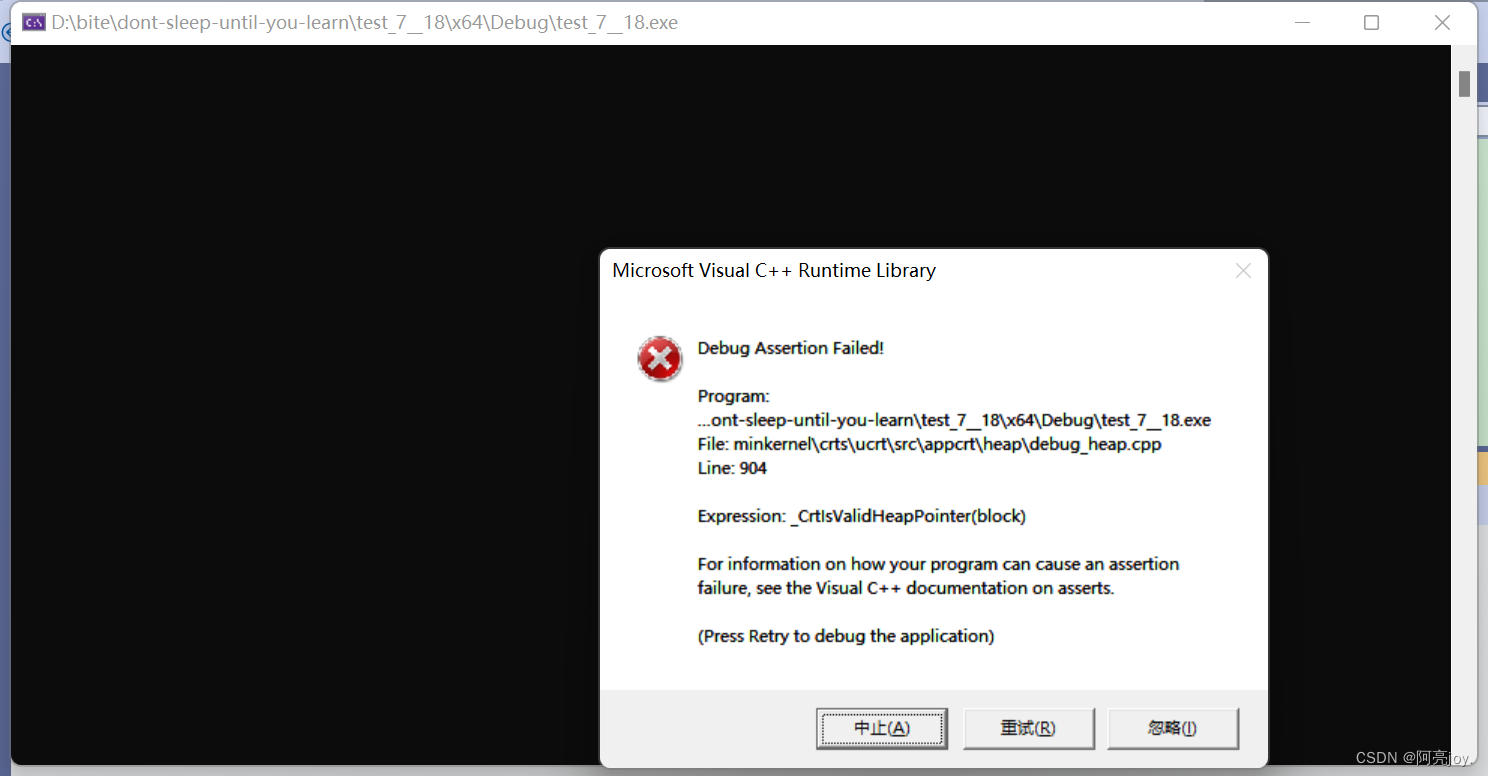
注意:上面的代码是一个错误的代码,原因就是free函数用于释放不是动态开辟的内存。我们写代码的时候一定要注意,free函数只能用于释放和回收动态开辟的内存,否则程序将会崩溃!!!
2.calloc
除了malloc函数,C语言还提供了一个函数calloc,calloc函数也能用来动态内存开辟。函数原型如下:
void* calloc (size_t num, size_t size);
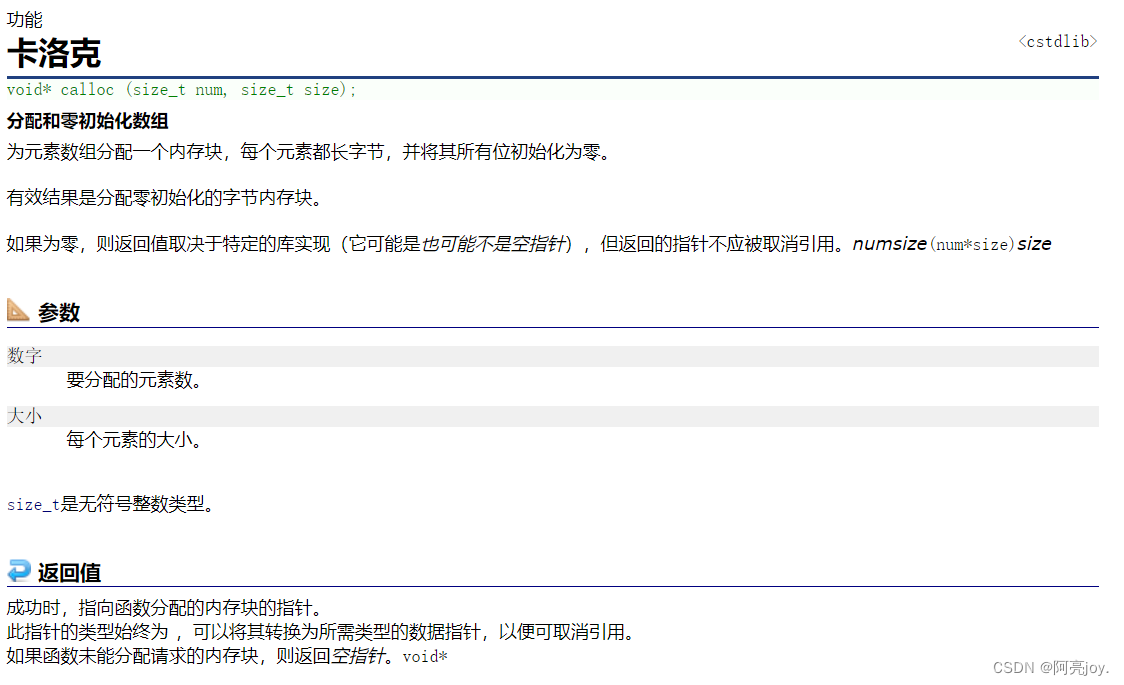
对于calloc函数,我们需要注意一下几点:
- 函数的功能是为num个大小为size的元素开辟一块空间,并且把空间的每个字节初始化为0。
- 与malloc函数的区别在calloc函数的参数有两个,而malloc函数的参数只有一个;还有就是calloc函数会在返回地址之前把申请的空间的每个字节初始化为全0。
代码示例:
#include <stdio.h>
#include <stdlib.h>
int main()
{
int* p = (int*)calloc(10,sizeof(int));
if (p == NULL)
{
perror("main");
return 1;
}
int i = 0;
for (i = 0; i < 10; i++)
{
*(p + i) = i;
}
free(p);
p = NULL;
return 0;
}
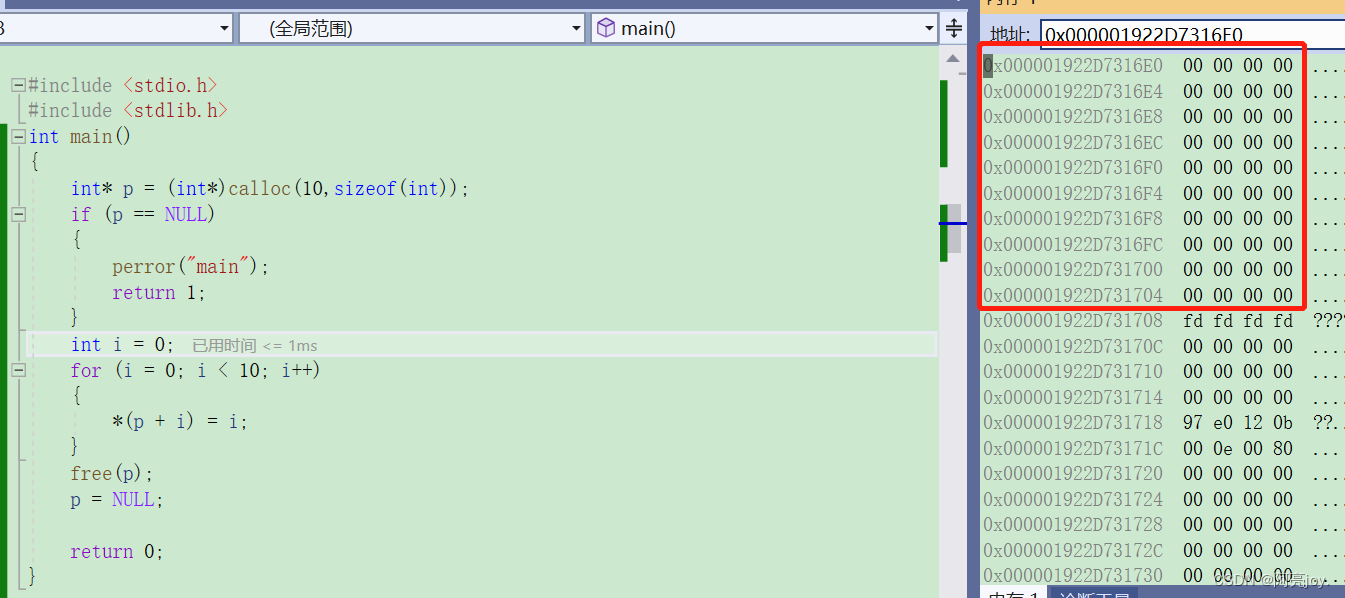
所以,如果我们对申请的内存空间的内容需要初始化,那么使用calloc函数就可以很方便地完成任务。
3.realloc
realloc函数的出现让动态内存管理更加灵活。有时会我们发现过去申请的空间太小了,有时候我们又会觉得申请的空间过大了,那为了合理的时候内存,我们一定会对内存的大小做灵活的调整。而realloc 函数就可以做到对动态开辟内存大小的调整。函数原型如下:
void* realloc (void* ptr, size_t size);
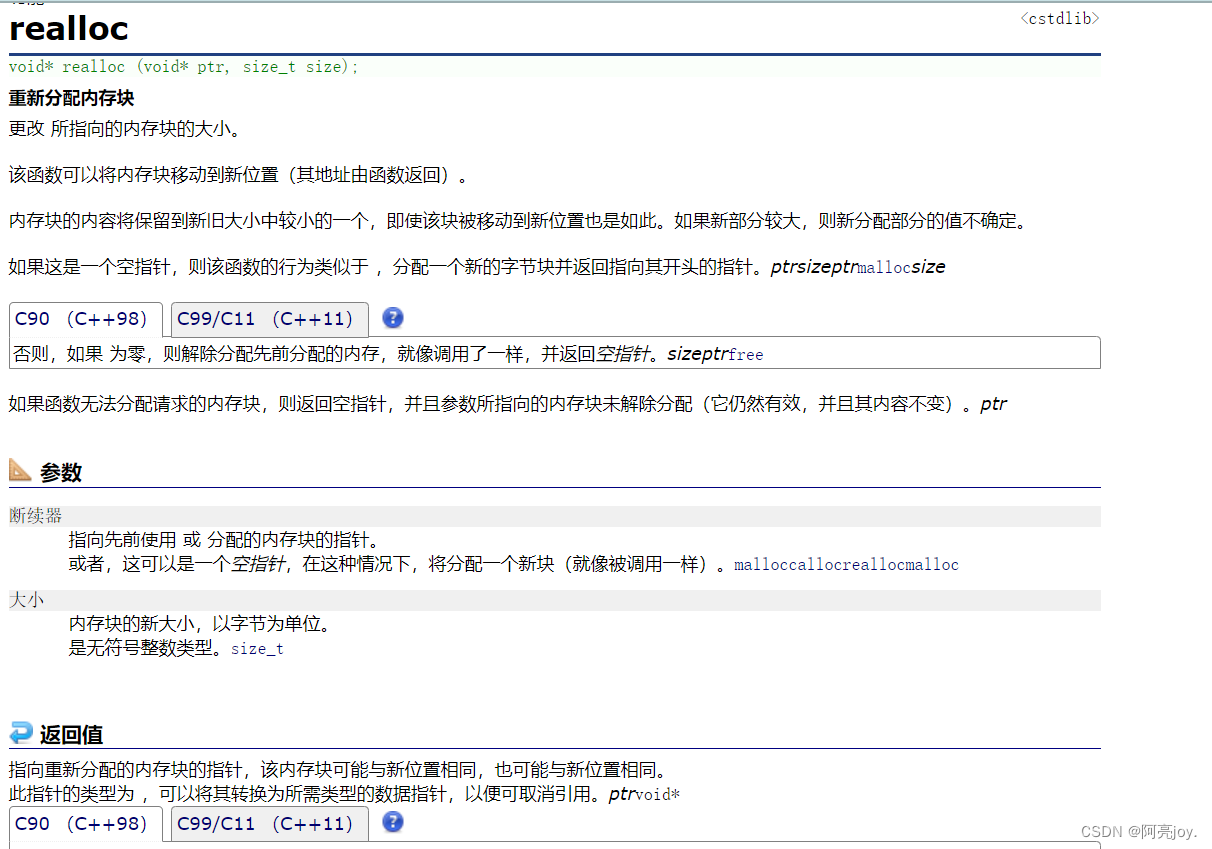
对于realloc函数,我们需要注意一下几点:
- ptr是要调整的内存地址。
- size为调整之后新大小。
- 返回值为调整之后的内存起始位置。
- 这个函数调整原内存空间大小的基础上,还会将原来内存中的数据移动到新的空间。
- realloc在调整内存空间的是存在两种情况:
- 情况1:原有空间之后有足够大的空间。
- 情况2:原有空间之后没有足够大的空间。
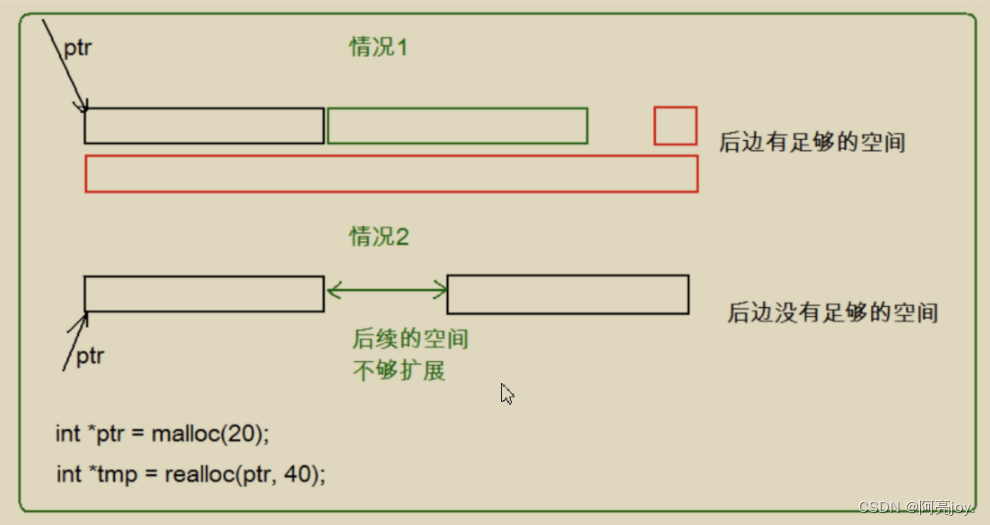
情况1:
当是情况1的时候,要扩展内存就直接原有内存之后直接追加空间,原来空间的数据不发生变化。
情况2:
当是情况2 的时候,原有空间之后没有足够多的空间时,扩展的方法是:在堆空间上另找一个合适大小的连续空间来使用。这样函数返回的是一个新的内存地址。
由于上述的两种情况,realloc函数的使用就要注意一些 。
**代码示例: **
#include <stdio.h>
#include <stdlib.h>
int main()
{
int* p = (int*)calloc(10,sizeof(int));
if (p == NULL)
{
perror("main");
return 1;
}
int i = 0;
for (i = 0; i < 10; i++)
{
*(p + i) = i;
}
//这里需要p指向的空间更大,需要20个int的空间
//relloc调整空间
int* ptr = (int*)realloc(p, 20 * sizeof(int));//防止p被置为空指针
if (ptr != NULL)
{
p = ptr;
}
for (i = 10; i < 20; i++)
{
*(p + i) = i;
}
//改变申请空间的大小,观察p的地址是否会变
free(p);
p = NULL;
return 0;
}
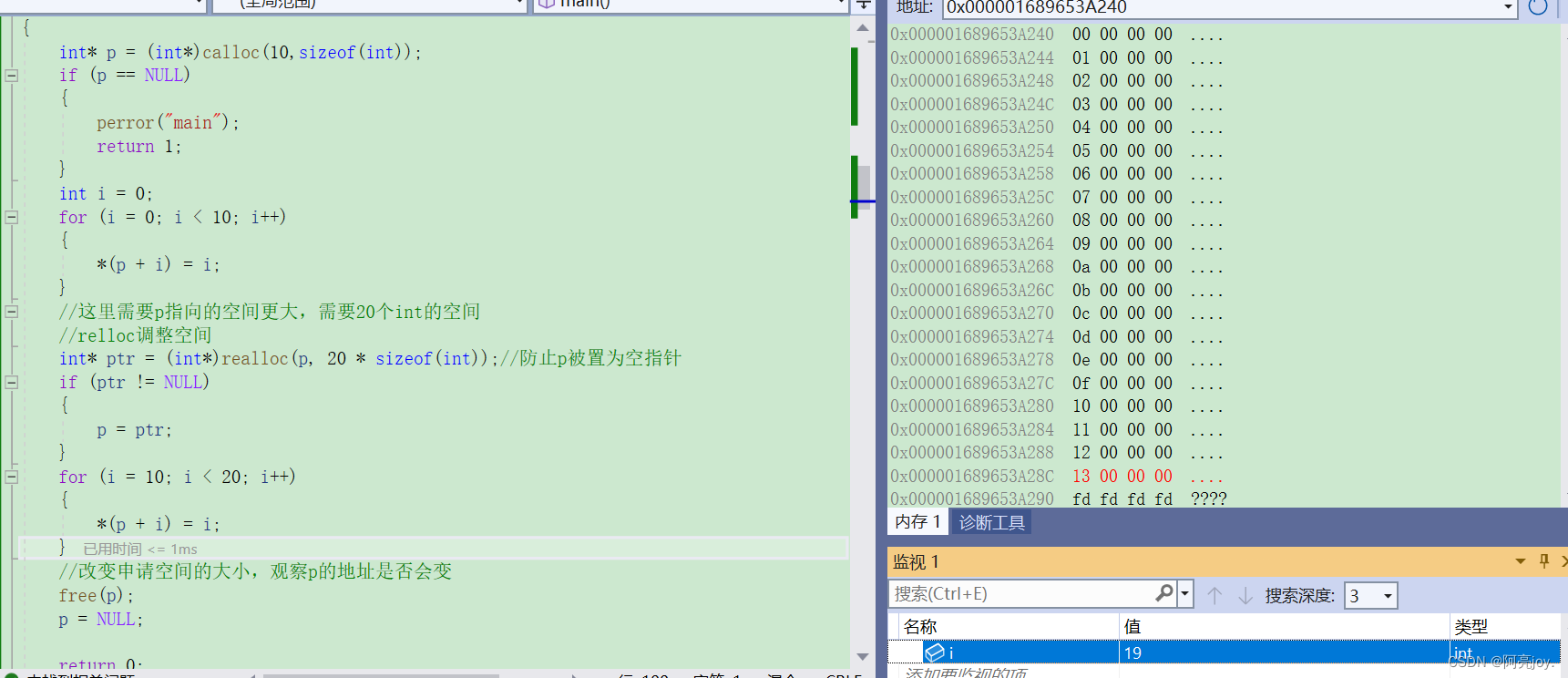
** 情况二代码示例:**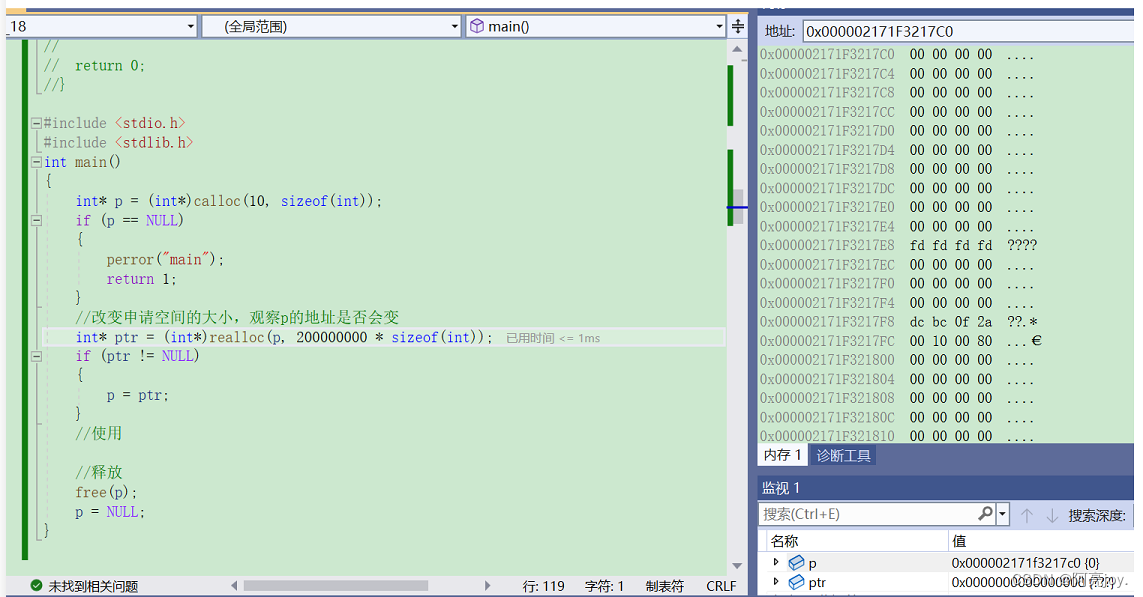

还有一个需要注意的是,realloc函数还可以充当malloc函数来使用。
int* p = (int*)realloc(NULL, 10 * sizeof(int));
<= = > int* p = (int*)malloc(10 * sizeof(int));
相信大家现在已经了解realloc函数了,接下来向大家介绍常见的动态内存错误。
常见的动态内存错误
1.对NULL指针的解引用操作
int main()
{
int* p = (int*)malloc(100000000000000000);
//错误:未对malloc函数的返回值做判断,就直接解引用了
int i = 0;
for (i = 0; i < 10; i++)
{
*(p + i) = i;
}
return 0;
}
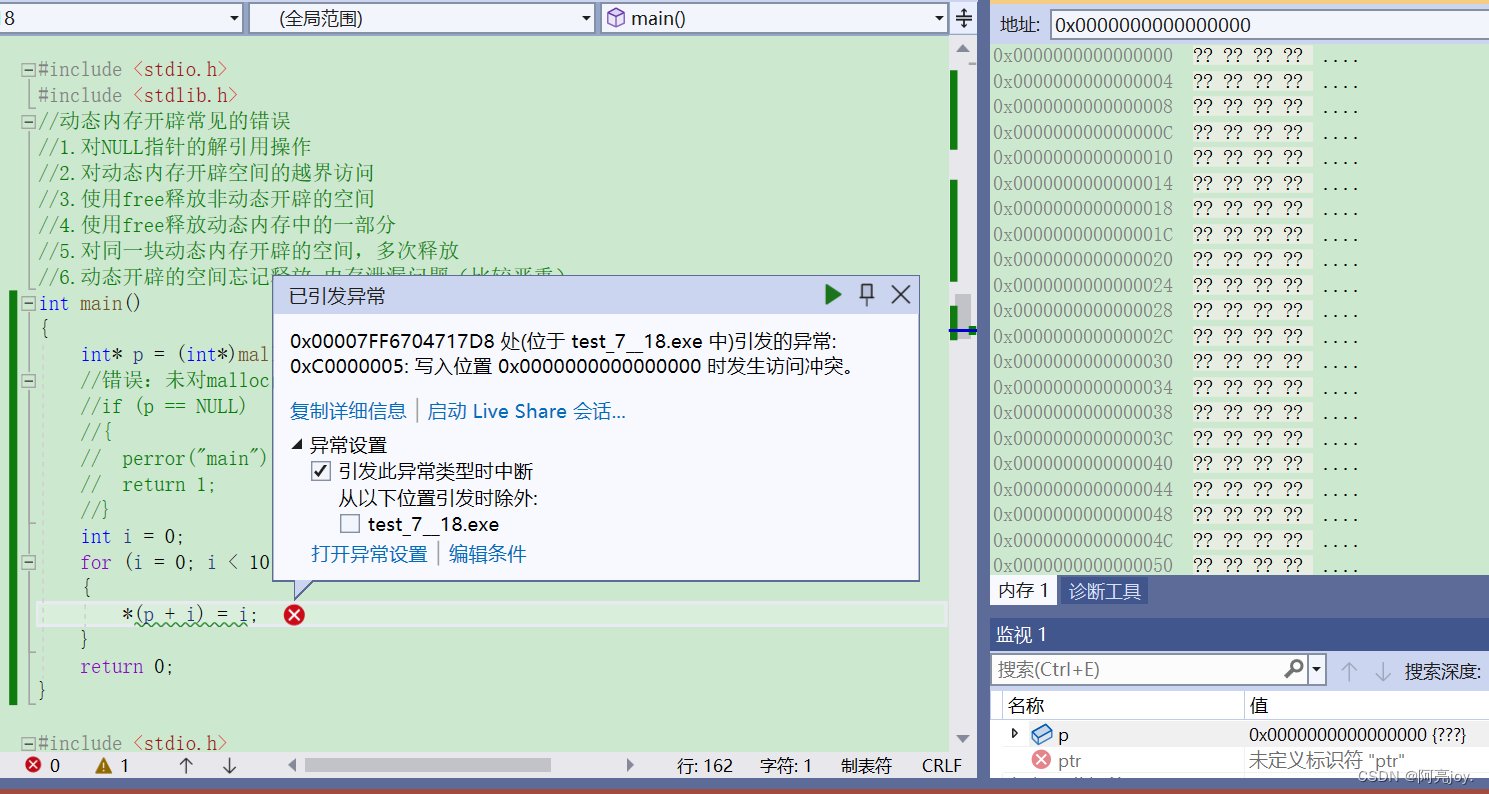
** 修改:**
int main()
{
int* p = (int*)malloc(100000000000000000);
//错误:未对malloc函数的返回值做判断,就直接解引用了
if (p == NULL)
{
perror("main");
return 1;
}
int i = 0;
for (i = 0; i < 10; i++)
{
*(p + i) = i;
}
return 0;
}

2.对动态开辟空间的越界访问
#include <stdio.h>
#include <stdlib.h>
int main()
{
int* p = (int*)malloc(10 * sizeof(int));
if (p == NULL)
{
return 1;
}
int i = 0;
//越界访问
for (i = 0; i < 40; i++)
{
*(p + i) = i;
}
free(p);
p = NULL;
return 0;
}
**修改: **
#include <stdio.h>
#include <stdlib.h>
int main()
{
int* p = (int*)malloc(10 * sizeof(int));
if (p == NULL)
{
return 1;
}
int i = 0;
//越界访问
for (i = 0; i < 10; i++)
{
*(p + i) = i;
}
free(p);
p = NULL;
return 0;
}
3.对非动态开辟内存使用free释放
#include <stdio.h>
#include <stdlib.h>
int main()
{
int arr[10] = { 0 };
int* p = arr;
//使用
//释放
free(p);
p = NULL;
return 0;
}
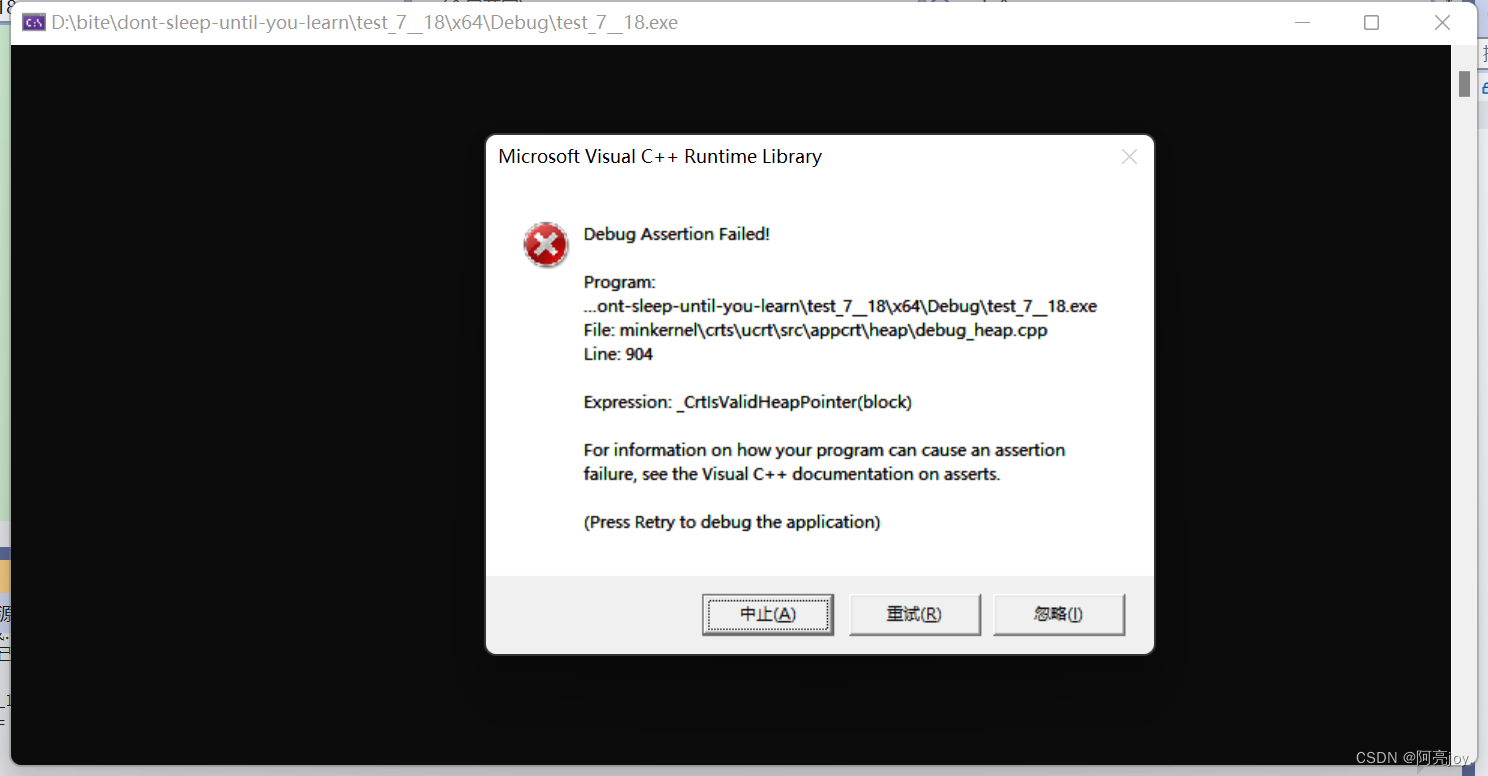
4.使用free释放一块动态开辟内存的一部分
#include <stdio.h>
#include <stdlib.h>
int main()
{
int* p = (int*)malloc(10 * sizeof(int));
if (p == NULL)
{
return 1;
}
int i = 0;
for (i = 0; i < 5; i++)
{
*p++ = i;
}
free(p);//p不再指向动态内存的起始位置
//
p = NULL;
}
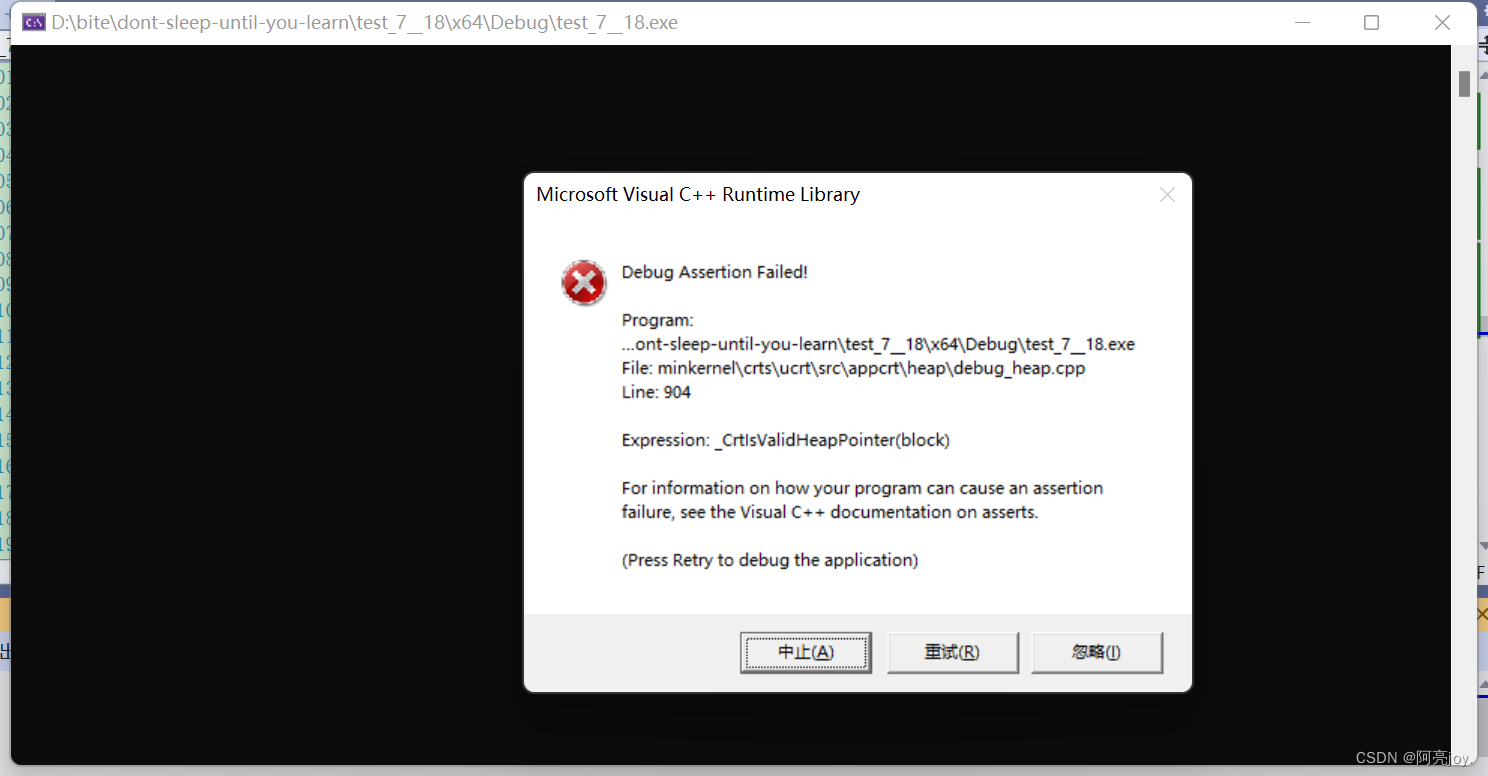
注意:free释放的动态内存空间一定是该空间的起始地址,否则程序将会崩溃。
5.对同一块动态内存多次释放
#include <stdio.h>
#include <stdlib.h>
int main()
{
int* p = (int*)malloc(100);
//使用
//释放
free(p);
//p=NULL;及时置空
//再一次释放
free(p);
return 0;
}

注意:释放动态开辟的内存后,一定要将指向该空间的指针置为空指针NULL。否则就很容易出现对同一块动态内存多次释放的问题,导致程序崩溃。
6.动态开辟内存忘记释放(内存泄漏)
#include <stdio.h>
#include <stdlib.h>
void test()
{
int* p = (int*)malloc(100);
if (p == NULL)
{
return;
}
//使用
}
int main()
{
test();
//...
return 0;
}
上面的代码运行时,不会爆出什么错误。但是忘记释放动态开辟的内存,就会导致内存泄漏,这样你的内存就会越来越少。这是非常严重的一个问题,所以使用完动态开辟的内存之后,一定要记得释放该内存并及时置空。
动态开辟的空间的两种回收方式:
- 主动free
- 程序结束
几道经典的笔试题
题目一
#include <stdio.h>
#include <stdlib.h>
#include <string.h>
void GetMemory(char* p)
{
p = (char*)malloc(100);
}
void Test(void)
{
char* str = NULL;
GetMemory(str);
strcpy(str, "hello world");
printf(str);
}
int main()
{
Test();
return 0;
}
**输出结果: **
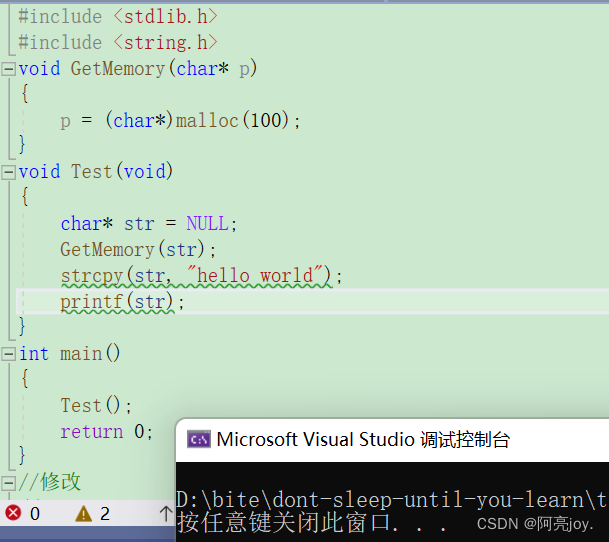
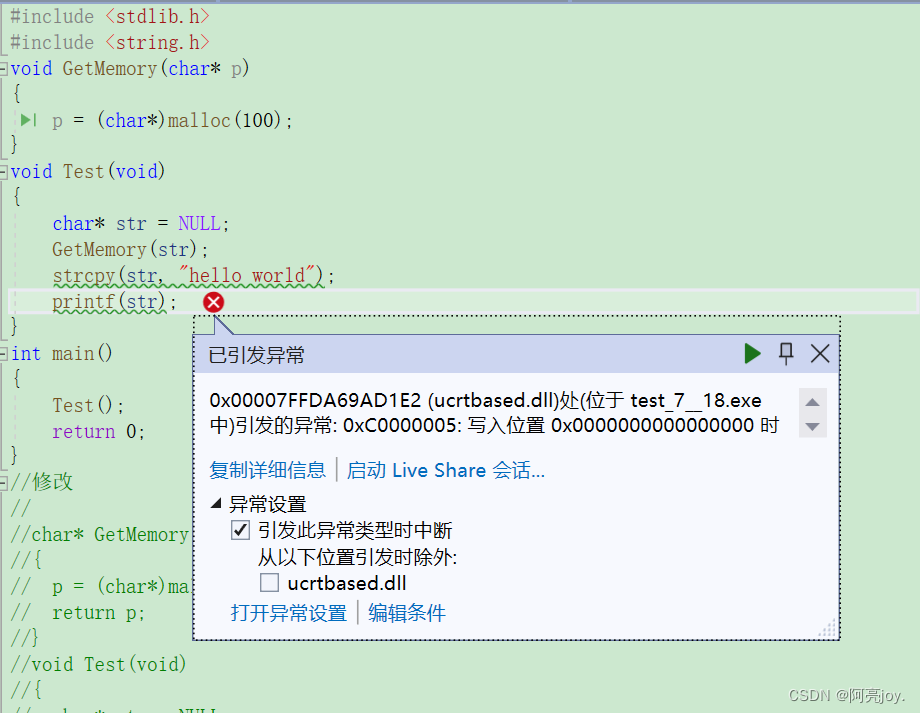
代码分析:

修改:
#include <stdio.h>
#include <stdlib.h>
#include <string.h>
char* GetMemory(char* p)
{
p = (char*)malloc(100);
return p;
}
void Test(void)
{
char* str = NULL;
str = GetMemory(str);
strcpy(str, "hello world");
printf(str);
//printf("hello world"); //传的是字符h的地址
free(str);
str = NULL;
}
int main()
{
Test();
return 0;
}
void GetMemory(char** p)
{
*p = (char*)malloc(100);
}
void Test(void)
{
char* str = NULL;
GetMemory(&str);
strcpy(str, "hello world");
printf(str);
//printf("hello world"); //传的是h的地址
free(str);
str = NULL;
}
int main()
{
Test();
return 0;
}

题目二
#include <stdio.h>
#include <stdlib.h>
#include <string.h>
char* GetMemory(void)
{
char p[] = "hello world";
return p;
}
void Test(void)
{
char* str = NULL;
str = GetMemory();
printf(str);
}
int main()
{
Test();
return 0;
}
** 输出结果:**
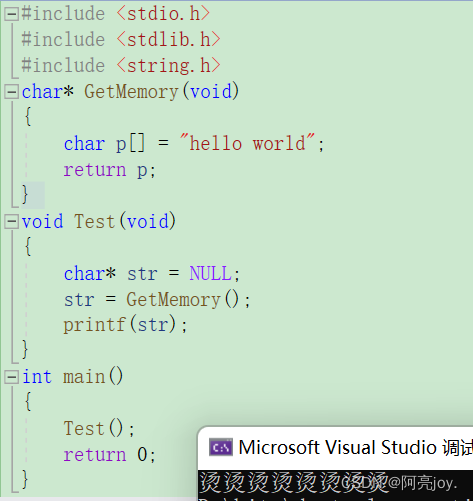
**代码分析: **
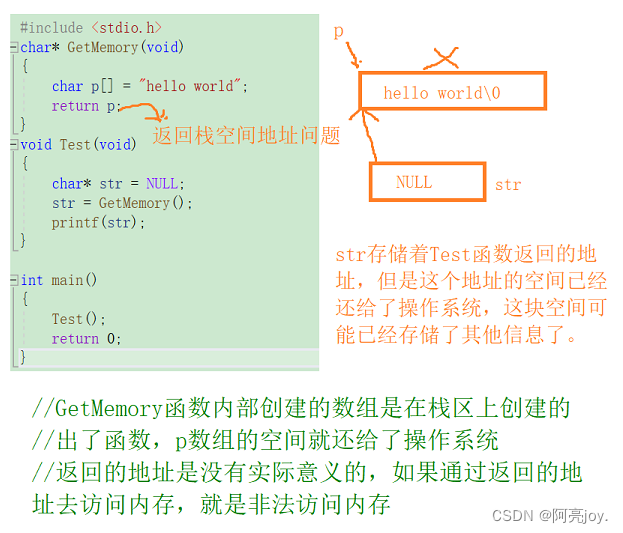
题目三
#include <stdio.h>
#include <stdlib.h>
#include <string.h>
void GetMemory(char** p, int num)
{
*p = (char*)malloc(num);
}
void Test(void)
{
char* str = NULL;
GetMemory(&str, 100);
strcpy(str, "hello");
printf(str);
}
int main()
{
Test();
return 0;
}
**输出结果: **
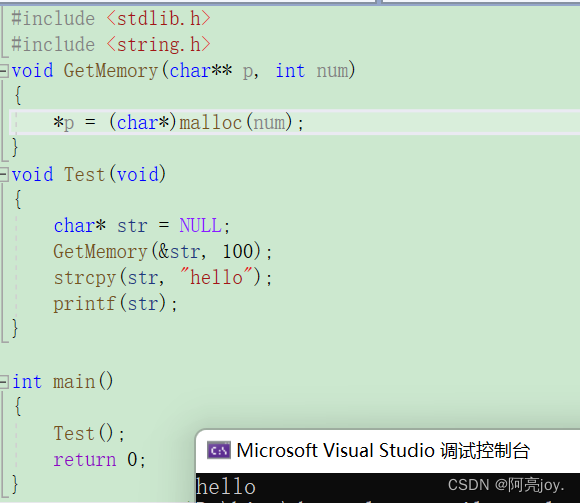
**代码分析: **
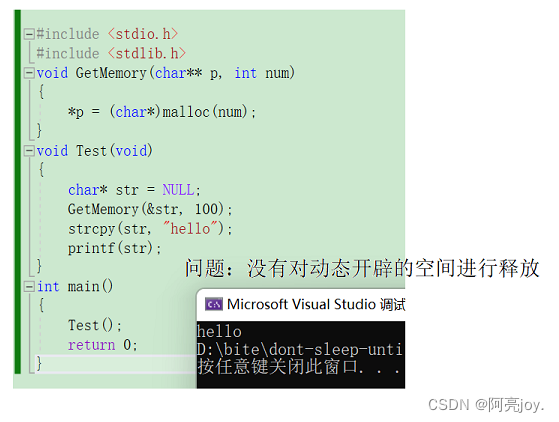
**修改: **
#include <stdio.h>
#include <stdlib.h>
#include <string.h>
void GetMemory(char** p, int num)
{
*p = (char*)malloc(num);
}
void Test(void)
{
char* str = NULL;
GetMemory(&str, 100);
strcpy(str, "hello");
printf(str);
free(str);
str = NULL;
}
int main()
{
Test();
return 0;
}
题目四
#include <stdio.h>
#include <stdlib.h>
#include <string.h>
void Test(void)
{
char* str = (char*)malloc(100);
strcpy(str, "hello");
free(str);
if (str != NULL)
{
strcpy(str, "world");
printf(str);
}
}
int main()
{
Test();
return 0;
}
**输出结果: **

**代码分析: **
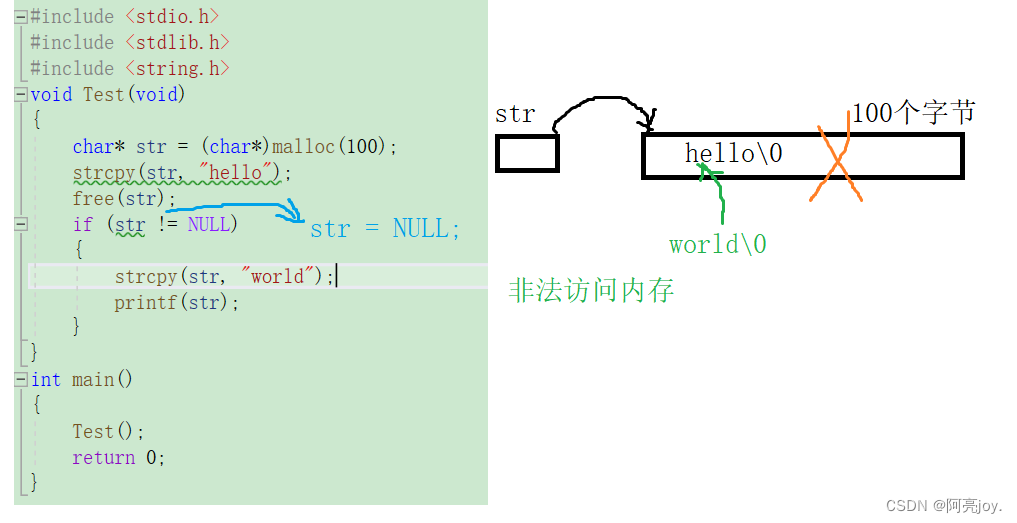
**修改: **
#include <stdio.h>
#include <stdlib.h>
#include <string.h>
void Test(void)
{
char* str = (char*)malloc(100);
strcpy(str, "hello");
free(str);
//动态内部释放后要及时置空
str = NULL;
if (str != NULL)
{
strcpy(str, "world");
printf(str);
}
}
int main()
{
Test();
return 0;
}
C/C++程序的内存开辟
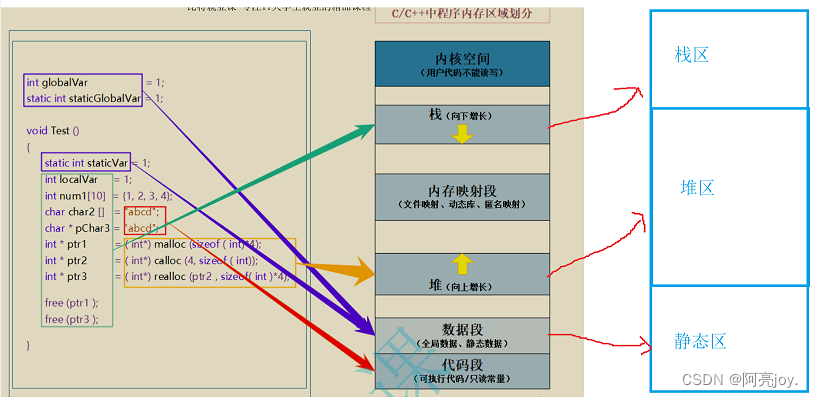
C/C++程序内存分配的几个区域:
- 栈区(stack):在执行函数时,函数内局部变量的存储单元都可以在栈上创建,函数执行结束时这些存储单元自动被释放。栈内存分配运算内置于处理器的指令集中,效率很高,但是分配的内存容量有限。 栈区主要存放运行函数而分配的局部变量、函数参数、返回数据、返回地址等。
- 堆区(heap):一般由程序员分配释放, 若程序员不释放,程序结束时可能由OS回收 。分配方式类似于链表。
- 数据段(静态区)(static)存放全局变量、静态数据。程序结束后由系统释放。
- 代码段:存放函数体(类成员函数和全局函数)的二进制代码。
有了这幅图,我们就可以更好的理解static关键字修饰局部变量的例子了。
实际上普通的局部变量是在栈区分配空间的,栈区的特点是在上面创建的变量出了作用域就销毁。但是被static修饰的变量存放在数据段(静态区),数据段的特点是在上面创建的变量,直到程序结束才销毁,所以生命周期变长。
柔性数组
也许你从来没有听说过柔性数组(flexible array)这个概念,但是它确实是存在的。C99 中,结构中的最后一个元素允许是未知大小的数组,这就叫做『柔性数组』成员。
举个例子:
struct S
{
int n;
int arr[];//大小是未知的
};
有些编译器会报错无法编译可以改成:
struct S
{
int n;
int arr[0];//大小是未知的
};
1.柔性数组的特点
- 结构中的柔性数组成员前面必须至少一个其他成员。
- sizeof 返回的大小不包括柔性数组的内存。
- 包含柔性数组成员的结构用malloc函数进行内存的动态分配,并且分配的内存应该大于结构的大小,以适应柔性数组的预期大小。
** 代码示例:**
#include <stdio.h>
struct S
{
int n;
int arr[0];//大小是未知的
};
int main()
{
struct S s = { 0 };
printf("%d\n", sizeof(s));
return 0;
}
**输出结果: **
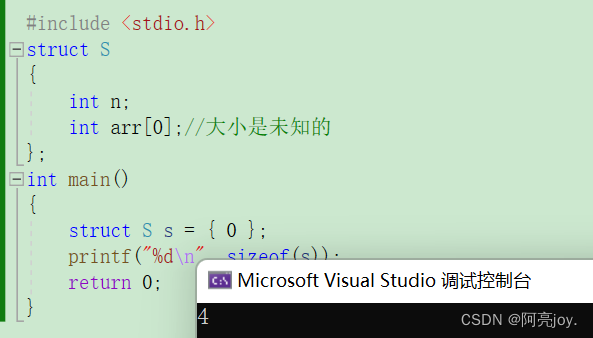
2.柔性数组的使用
使用方法一:
#include <stdio.h>
#include <stdlib.h>
struct S
{
int n;
int arr[0];//大小是未知的
};
int main()
{
//期望arr的大小是10个整型
struct S* ps = (struct S*)malloc(sizeof(struct S) + 10 * sizeof(int));
ps->n = 10;
int i = 0;
for (i = 0; i < 10; i++)
{
ps->arr[i] = i;
}
//增容
struct S* ptr = (struct S*)realloc(ps, sizeof(struct S) + 20 * sizeof(int));
if (ptr != NULL)
{
ps = ptr;
}
//使用
//释放
free(ps);
ps = NULL;
return 0;
}

**使用方法二: **
#include <stdio.h>
#include <stdlib.h>
struct S
{
int n;
int* arr;
};
int main()
{
struct S* ps = (struct S*)malloc(sizeof(struct S));
if (ps == NULL)
return 1;
ps->n = 10;
ps->arr = (int*)malloc(10 * sizeof(int));
if (ps->arr == NULL)
return 1;
int i = 0;
for (i = 0; i < 10; i++)
{
ps->arr[i] = i;
}
for (i = 0; i < 10; i++)
{
printf("%d ", ps->arr[i]);
}
//增容
int* ptr = (int*)realloc(ps->arr, 20 * sizeof(int));
if (ptr != NULL)
{
ps->arr = ptr;
}
//使用
//释放需要两次
free(ps->arr);
ps->arr = NULL;
free(ps);
ps = NULL;
return 0;
}
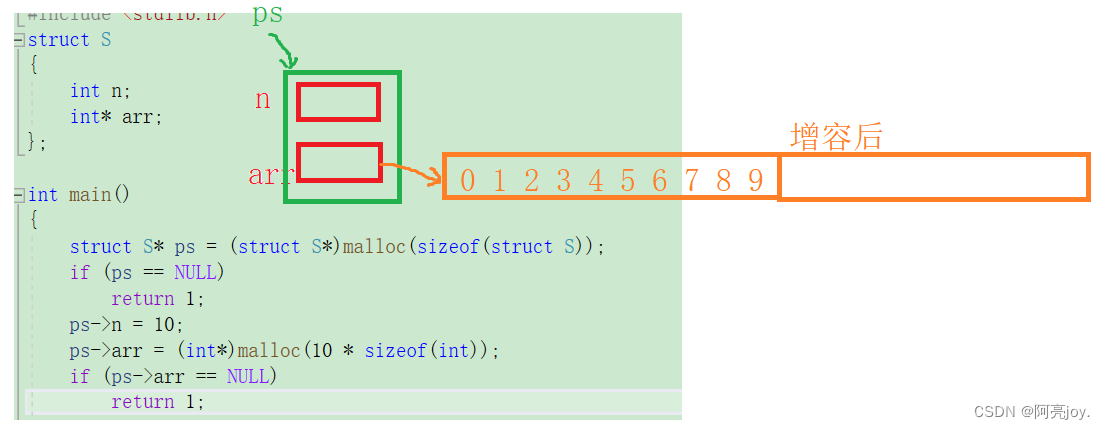
注意:上面的两种使用方法,本人推荐使用第一种。因为如果我们的代码是在一个给别人用的函数中,你在里面做了二次内存分配,并把整个结构体返回给用户。用户调用free可以释放结构体,但是用户并不知道这个结构体内的成员也需要free,你不能指望用户来发现这个事。所以,如果我们把结构体的内存以及其成员要的内存一次性分配好,并返回给用户一个结构体指针,用户做一次free就可以把所有的内存也给释放掉,出错的可能性会更小。同时第一种方法访问内存的速度也会更高,因为连续的内存有益于提高访问速度,也有益于减少内存碎片。
以上就是本篇博客的全部内容了,如果大家觉得有收获的话,可以点个赞支持一下!
版权归原作者 阿亮joy. 所有, 如有侵权,请联系我们删除。